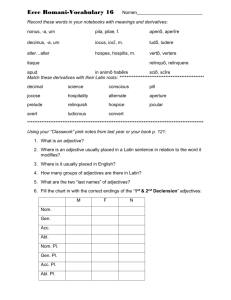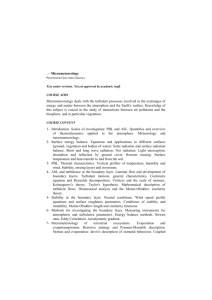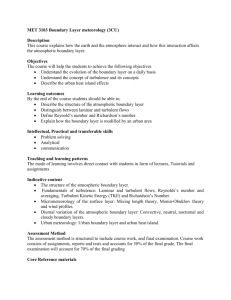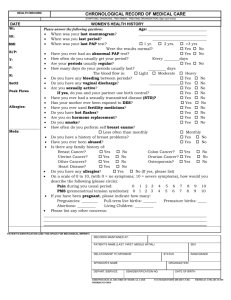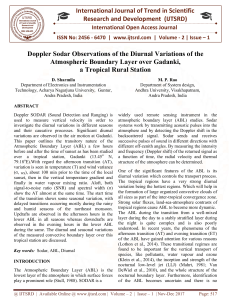1.1 Introduction and Surface Energy Balance
advertisement
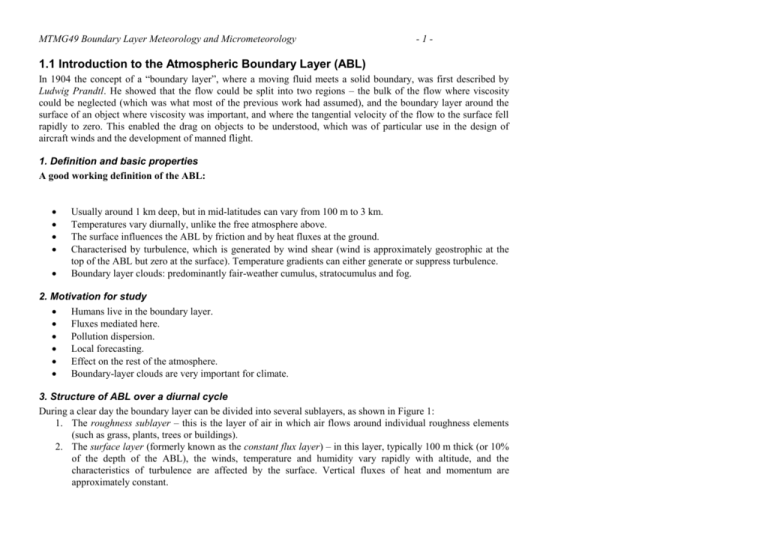
MTMG49 Boundary Layer Meteorology and Micrometeorology -1- 1.1 Introduction to the Atmospheric Boundary Layer (ABL) In 1904 the concept of a “boundary layer”, where a moving fluid meets a solid boundary, was first described by Ludwig Prandtl. He showed that the flow could be split into two regions – the bulk of the flow where viscosity could be neglected (which was what most of the previous work had assumed), and the boundary layer around the surface of an object where viscosity was important, and where the tangential velocity of the flow to the surface fell rapidly to zero. This enabled the drag on objects to be understood, which was of particular use in the design of aircraft winds and the development of manned flight. 1. Definition and basic properties A good working definition of the ABL: Usually around 1 km deep, but in mid-latitudes can vary from 100 m to 3 km. Temperatures vary diurnally, unlike the free atmosphere above. The surface influences the ABL by friction and by heat fluxes at the ground. Characterised by turbulence, which is generated by wind shear (wind is approximately geostrophic at the top of the ABL but zero at the surface). Temperature gradients can either generate or suppress turbulence. Boundary layer clouds: predominantly fair-weather cumulus, stratocumulus and fog. 2. Motivation for study Humans live in the boundary layer. Fluxes mediated here. Pollution dispersion. Local forecasting. Effect on the rest of the atmosphere. Boundary-layer clouds are very important for climate. 3. Structure of ABL over a diurnal cycle During a clear day the boundary layer can be divided into several sublayers, as shown in Figure 1: 1. The roughness sublayer – this is the layer of air in which air flows around individual roughness elements (such as grass, plants, trees or buildings). 2. The surface layer (formerly known as the constant flux layer) – in this layer, typically 100 m thick (or 10% of the depth of the ABL), the winds, temperature and humidity vary rapidly with altitude, and the characteristics of turbulence are affected by the surface. Vertical fluxes of heat and momentum are approximately constant. MTMG49 Boundary Layer Meteorology and Micrometeorology -2- Figure 1. (Left) Typical profiles of potential temperature, wind and humidity over land in midlatitudes during cloudless conditions. (Right) Schematics of the typical ABL circulation and eddy structure of the ABL in the day and night (from Kaimal and Finnigan 1994). Day Night MTMG49 Boundary Layer Meteorology and Micrometeorology -3- 3. The well-mixed layer – rising buoyant plumes from the surface layer, and associated turbulence, cause potential temperature and other quantities to be relatively constant with altitude. The earth’s rotation becomes important in this layer, and the wind direction veers with height. 4. The capping inversion – on a summer’s day the convective boundary layer is often capped by a temperature inversion, which inhibits mixing and confines air and pollution below it to within the boundary layer. At night a new stable nocturnal boundary layer grows as air is cooled from the surface. The daytime mixed-layer remains as a residual layer while the capping inversion is eroded. Sometimes the ABL is difficult to define; in the vicinity of fronts there is no obvious capping inversion and the ABL structure is more a response to synoptic forcing. 4. Surface energy balance (Recap of material from Section D2 of Atmospheric Physics notes) The surface energy balance drives the diurnal variation in the ABL. For an infinitely thin “surface layer” of the ground, we have the following balance (with all terms in W m-2): Rn G H E , where Rn is the net irradiance (“net radiation”) into the surface. G is the ground heat flux density by conduction from the surface layer of the ground into the ground beneath. H is the sensible heat flux density: the heating of the atmosphere by loss of energy from the surface. E is the latent heat flux density: the loss of energy by evaporation (evaporation rate E has units kg m-2 s-1 and the specific latent heat of evaporation is =2.5106 J kg-1). Global, diurnal mean values of these variables: 5. Bowen ratio The nature of the ABL is determined by the balance between H and E, which depends on surface moisture availability. A convenient parameter is the Bowen ratio, defined as B= H / E. It is not suitable for parameterisation schemes in numerical models but it is conceptually helpful. Typical values at midday over different surfaces are: Vegetated surface Ocean MTMG49 Boundary Layer Meteorology and Micrometeorology Urban area Desert -4- Figure 2. Schematic of the typical evolution of the boundary layer over one diurnal cycle. Further reading: Stull, Chapter 1. For next time: Please be familiar with the material in section D5 of your Atmospheric Physics notes. Figure 3. Diurnal cycle of the components of the surface energy budget in in cloudless conditions at a rural midlatitude site.





